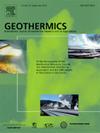利用TRNSYS仿真工具对太阳能辅助地源热泵系统进行优化及性能分析
IF 3.5
2区 工程技术
Q3 ENERGY & FUELS
引用次数: 0
摘要
利用TRNSYS软件建立数学模型,并结合实验数据进行验证,对太阳能辅助地源热泵(SAGSHP)系统进行多目标优化设计。SAGSHP系统由一个垂直钻孔u型管地面热交换器(GHE)和一个集成太阳能平板集热器(SFC)组成,用于满足突尼斯北部气候条件下典型家庭的空间供暖需求。以地源热泵(COPHP)的平均性能系数作为评价参数,对u型管地源热泵(GHE)、地源热泵(GHP)、地源热泵(SFC)和地板辐射采暖系统(RFH)进行了优化。优化过程确定了u型管GHEs的数量、深度、每个u型管中循环流体的质量流量、RFH管间距、RFH内的质量流量、SFC的表面积以及集热器中循环的流体质量流量。优化的解决方案是使用在一个案例研究来评估使用的可行性SAGSHP空间加热系统在家庭面积145 m²和12的热负荷kW.Simulation结果表明,能量恢复从地面通过u形管GHE是80千瓦,交付的热泵能量是95千瓦,香港证监会贡献27%的阳光期间所需的加热能源,地热热泵的性能系数是4,45。本文章由计算机程序翻译,如有差异,请以英文原文为准。
Optimization and behavior result analysis of a solar assisted ground source heat pump system using TRNSYS simulation tool
In this paper, a mathematical model, developed using TRNSYS software and validated against experimental data, is employed to conduct a multi-objective design optimization for a solar-assisted ground source heat pump (SAGSHP) system. The SAGSHP system consists of a vertical borehole U-tube ground heat exchanger (GHE) and an integrated solar flat-plate collectors (SFC), which are used to meet the space heating needs of a typical household in the climatic conditions of Northern Tunisia. The average coefficient of performance of the geothermal heat pump (COPHP) is used as an evaluation parameter to optimize the sub-systems of the SAGSHP: the U-tube GHE, the heat pump (GHP), the SFC, and the radiant floor heating system (RFH). The optimization process determines the number of U-tube GHEs, their depth, the mass flow rate of the circulating fluid in each U-tube, the pipe spacing of the RFH, the mass flow rate in the RFH, and the surface area of the SFC as well as the fluid mass flow rate circulating in the collectors. The optimized solution is then used in a case study to assess the feasibility of using the SAGSHP system for space heating in a household with an area of 145 m² and a heating load of 12 kW.
Simulation results show that the energy recovered from the ground via U-tube GHE is 80 kW, the heat pump delivered energy is 95 kW, the SFC contributes by 27 % of the required heating energy during sunny period and the geothermal heat pump’s coefficient of performance is 4,45.
求助全文
通过发布文献求助,成功后即可免费获取论文全文。
去求助
来源期刊

Geothermics
工程技术-地球科学综合
CiteScore
7.70
自引率
15.40%
发文量
237
审稿时长
4.5 months
期刊介绍:
Geothermics is an international journal devoted to the research and development of geothermal energy. The International Board of Editors of Geothermics, which comprises specialists in the various aspects of geothermal resources, exploration and development, guarantees the balanced, comprehensive view of scientific and technological developments in this promising energy field.
It promulgates the state of the art and science of geothermal energy, its exploration and exploitation through a regular exchange of information from all parts of the world. The journal publishes articles dealing with the theory, exploration techniques and all aspects of the utilization of geothermal resources. Geothermics serves as the scientific house, or exchange medium, through which the growing community of geothermal specialists can provide and receive information.
 求助内容:
求助内容: 应助结果提醒方式:
应助结果提醒方式:


